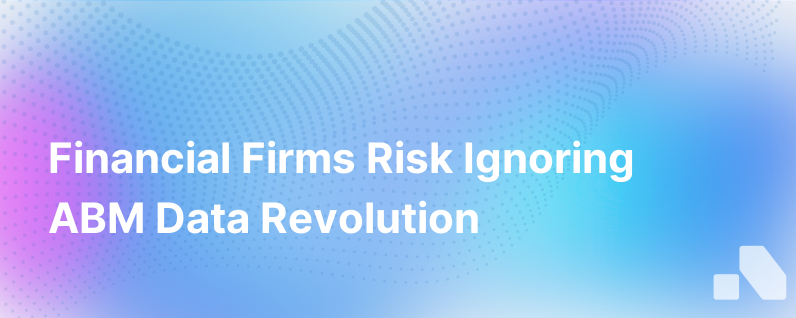Financial Services Firms Risk Missing The Boat On The Abm Data Revolution
Published on November 19, 2023 by Sawyer Middeleer
The advent of Account-Based Marketing (ABM) has transformed the landscape of B2B marketing, elevating the strategic importance of data in crafting tailored, impactful interactions with high-value accounts. In a rapidly evolving digital economy, where personalization and customer experience are paramount, ABM represents a pivotal opportunity for financial services firms to fine-tune their targeting precision, deepen client relationships, and unlock growth avenues.
But there's an iceberg ahead that might snag firms lagging in the data revolution; many financial services firms are at risk of missing the ABM boat altogether. Wading through the complexity and regulatory quandaries, these firms must leverage data effectively or watch as more agile competitors sail away with the prize.
The ABM Imperative in Financial Services Marketing
ABM is more than a trendy acronym. It's an approach that flips traditional marketing on its head – instead of casting a wide net to attract a broad audience, it hones in on a set of chosen accounts like a laser beam, curating experiences, messages, and solutions uniquely aligned with each account's distinct needs and challenges.
For financial services firms, ABM is not just an efficient marketing strategy; it's a competitive necessity. The financial sector thrives on trust, reputation and bespoke solutions. The 'one-size-fits-all' marketing messages of yesteryears do not cater to the sophisticated, highly specialized needs of today’s clients who demand tailored solutions.
From wealth management and insurance to corporate banking, and beyond, financial institutions know their high-value clients by name, along with their preferences, investment history, and future aspirations. The stakes are high, and the bespoke nature of services offered can greatly benefit from a strategic ABM approach informed by robust, actionable data insights.
The ABM Data Revolution: A Sea Change in Targeted Marketing
The ABM data revolution refers to the heightened role of data analytics in personalizing marketing at an account-specific level. Data-driven ABM goes beyond segmenting audiences into broad categories, delving into the realm of predictive analytics, AI-driven insights, and real-time data to enable hyper-personalization.
Understanding a client's current portfolio, past interactions, market behavior, and even sentiment analysis allows financial services marketers to tailor their approach with unprecedented specificity. When a firm can predict a client's needs before the client themselves is conscious of them, it creates opportunities to forge stronger relationships, present preemptive solutions, and position itself as an indispensable financial partner.
The Risks of Missing the Boat
Despite the clear blue ocean of opportunity that ABM brings, many financial services firms remain anchored to the harbor of traditional marketing strategies. The reluctance to embark on the data-driven journey comes with considerable risks:
-
Lost Market Share: While slow movers are hesitating, competitors that embrace ABM are capturing the attention, loyalty, and business of high-value clients.
-
Decreased Relevance: Failure to utilize data in marketing means missed opportunities in understanding client needs and staying ahead of market trends, rendering a firm's offerings less relevant.
-
Inefficient Resource Allocation: Without the account-level focus of ABM, financial services firms may find themselves spending more for less return, as blanket marketing efforts tend to be less efficient compared to targeted ABM campaigns.
-
Operational Inertia: As ABM paradigms become industry standards, late adopters face the difficulty of overhauling entrenched processes and systems.
Navigating Regulatory Waters
The financial sector, one of the most heavily regulated industries, requires firms to navigate the complex waters of compliance, especially when handling client data. The ethical use of data, privacy concerns, and regulatory restrictions like GDPR and other local data protection laws can be formidable. They demand an approach where compliance is in the DNA of all marketing strategies.
This added layer of complexity shouldn’t serve as a deterrent but as a spur for innovation within compliant frameworks. Data security and privacy should be seamlessly integrated into the ABM approach, ensuring that regulation is a guardrail rather than a roadblock.
Charting the Course for ABM Success in Financial Services
To seize the ABM opportunity and not be left adrift, financial services firms must take decisive steps:
- Invest in Data Capabilities: Building or acquiring analytics capabilities is essential for synthesizing and interpreting big data, drawing actionable insights for strategic account targeting.
- Adopt Tech Platforms: Leveraging powerful ABM platforms like Aomni can give financial services firms the tools for real-time account research, competitive insights, and personalized sales content without the typical heavy lifting required.
- Cultivate Data Culture: Education, training, and an organizational mindset shift are required to weave data through the fabric of marketing strategies.
- Seek Expertise: Outsourcing, partnerships, or hiring for data science expertise can fill in knowledge gaps and help firms develop compliant ABM strategies.
- Measure and Refine: ABM necessitates consistent performance tracking, alongside a willingness to iterate and refine efforts based on real-world response and feedback.
Conclusion
In conclusion, the ABM data revolution is not just an incremental change; it's a paradigm shift in how value is delivered to high-potential accounts in the financial services sector. Firms that recognize this change and invest in data-driven ABM strategies will reap the benefits of deeper client engagement and robust growth. It is time for these institutions to set sail on the ABM voyage – aligning data analytics with strategic business goals while navigating the regulatory currents – to harness the full potential of the opportunities that lie ahead.